Have you ever thrown in the towel on your weight loss efforts because you are tired of feeling deprived + hungry? You are not alone. The vicious cycle of eating less, cutting calories, banishing your favorite foods, letting yourself get so hungry that you overeat + snack yourself into defeat. Sound familiar? Welcome to Calorie Density 101 and the concept of how to lose weight eating more food. Understanding calorie density is the missing link to breaking the cycle. How about increased portion sizes and actually feeling full after a meal, while consuming less calories?!?! Yes!
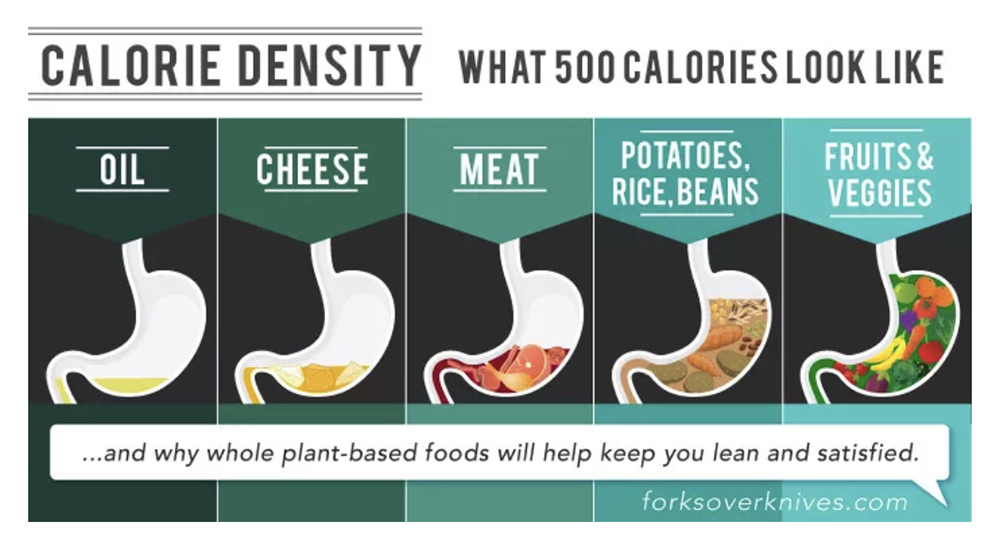
Understanding Calorie Density
I am living proof that the being mindful of calorie density works. I consume a lot of food in a day. However, I consume foods with very low-calorie-density. Study after study has shown us that to maintain a healthy weight (or lose weight), we need to eat foods that make us feel full. How can we do that without consuming too much? Eat more foods that have a low-calorie-density and in turn you will be eating foods with more nutrients + fiber while taking in less calories. Eating this way helps ward off the eternal feeling of hunger and breaks the dieting cycle. 🙌🙌🙌
This way of eating does not restrict you to a certain diet. You are not cutting out any specific food or food groups. Alternatively, you eat foods that make you feel full. When your stomach senses that you have eaten a large volume of food, you stop eating. This is where calorie density becomes super important. A large volume of fruits or vegetables has significantly less calories than a large volume of chips or crackers. If I eat 2 cups of raw broccoli, I will be full. If I eat 2 cups of potato chips, maybe not. I could keep eating cups full of broccoli if I were still hungry and still not get to the calorie count in those chips.
The chart below gives you an idea of the types of foods that will be more calorie dense per pound (extracted from How Not To Diet).
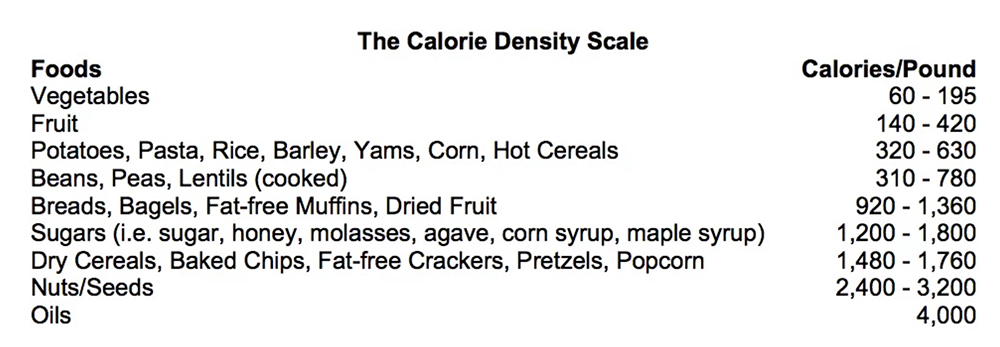
Concentrated Calories
Think of food density as concentrated calories. This is one of the main take-aways to learn in Calorie Density 101. In order to lose weight eating more food, you need to consume foods with a lower concentration of calories. Foods with more bulk (water and fiber) have less calories with more volume of food. Foods with a higher concentration of calories allow you to consume smaller quantities of food per serving.
In other words, some foods have more calories per cup (or pound or tablespoon) than others. For example, one tablespoon of oil is about 120 calories. The same number of calories in about 2 cups of blueberries. Which one do you think makes you feel fuller? The same goes for potatoes. One large order of French fries is the same number of calories as 4 baked potatoes. Again, which one is more filling? How about this one – it also takes 22 cups of fresh strawberries to equal the number of calories in 1 pint of strawberry ice cream!!!
The image below helps to visualize what filling your stomach with 2000 calories of different foods might look like. (nutritionfacts.org)
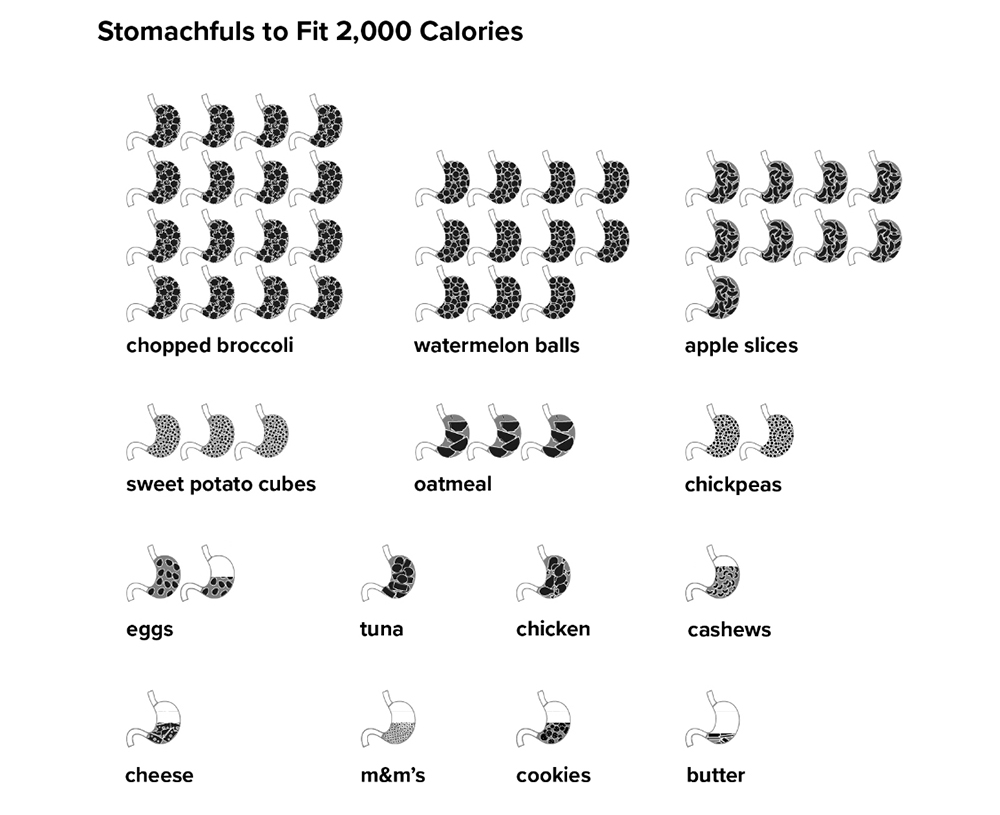
Plant-Based Eating + Calorie Density 101
Switching your mindset to calculating calorie density over number of calories is easy and just takes a little practice. We have been slaves to the calories-in vs calories-burned mentality. However, this concept has been proven in many credible studies, not to be the most effective weight loss tool. Learning how to lose weight eating more food is actually easy!
What makes it even easier? Eating a whole food, plant-based diet. Ha, this is a vegetarian food blog after all, you knew I would bring it around at some point, didn’t you?
I like to use the term dietary displacement.
Plant-Based Diets Are Full Of Water-Rich + Fiber-Filled Foods
With plant-based eating, you end up eating a higher volume of food with less calories than meat-based foods. The more plants you consume, you will naturally be consuming fewer calories because there is only so much space in your stomach before you start feeling full. The key is to become so full on the real, whole foods, you have less room in your stomach for the processed foods devout of nutritional value. You might be tempted to argue with me the point that fat and protein are more satiating than carbohydrates, and this does hold some truth. However, the volume of the food matters far more when comparing calorie to calorie.
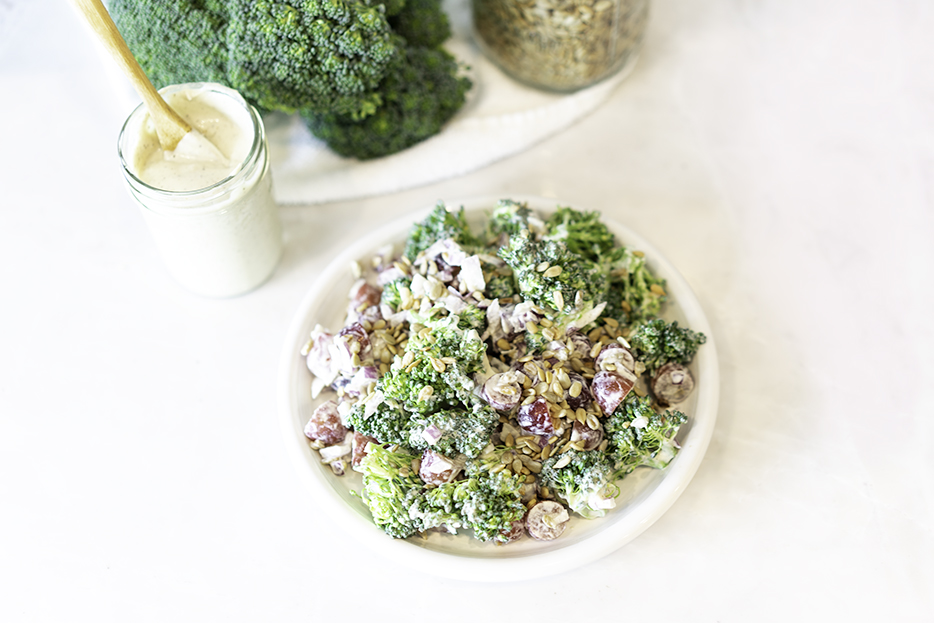
How To Make Calorie Density Work In Your Favor
Empty calories are still empty calories. Being vegan or vegetarian or even flexitarian does not prevent a person from consuming empty calories. Vegan junk food does exist. This concept of learning how to lose weight eating more food only works if you regularly follow the principles of consuming high water + fiber content foods with low-calorie-density. Check out my article if you aren’t quite sure if plant-based eating is for you(What Is A Whole Food, Plant-Based Diet). Being plant-based makes this very easy!!!
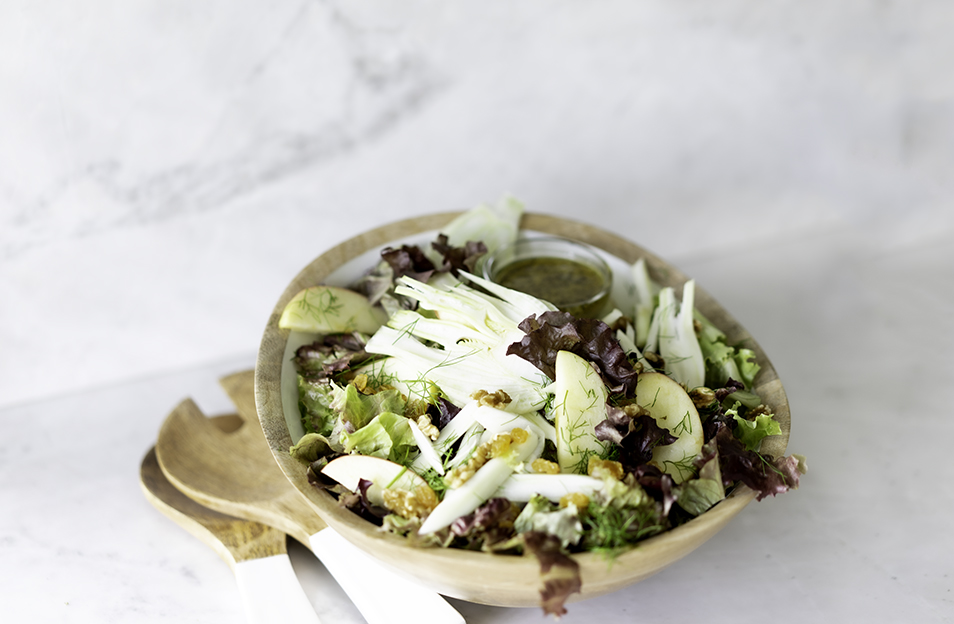
A Few Tips To Help Get You Started:
- Start each meal with a salad, cut up veggies, soup, or a fruit. Multiple nutritional research studies tell us that this has been proven to work. Remember, your stomach can only hold so much, so fill it up with the high water and fiber content foods first and leave less room for the high-calorie-density foods.
- Don’t drink your calories. Liquids (think juice or smoothies) are not satisfying. The whole, solid food that you must chew fills your stomach more leading you to consume less overall calories.
- Add vegetables to EVERY meal. Yes, even breakfast. This always helps with lowering the calorie density.
- Avoid oils/fats as much as possible. These bring up the calorie density a lot. Remember one tablespoon of oil can equal the same calories as up to 2 cups of berries. We here at MVF avoid oils as much as possible and it isn’t difficult! Check out my Guide to Oil-Free Cooking to get started.
- If you want to eat high-calorie-density foods, incorporate them into low-calorie-density meals. For example, add nuts to your oatmeal, avocado or dried fruit into your salad.
- Remember: low-calorie-density foods are typically whole, unrefined, unprocessed foods with high water content and high fiber content. Eat them first + eat more of them!
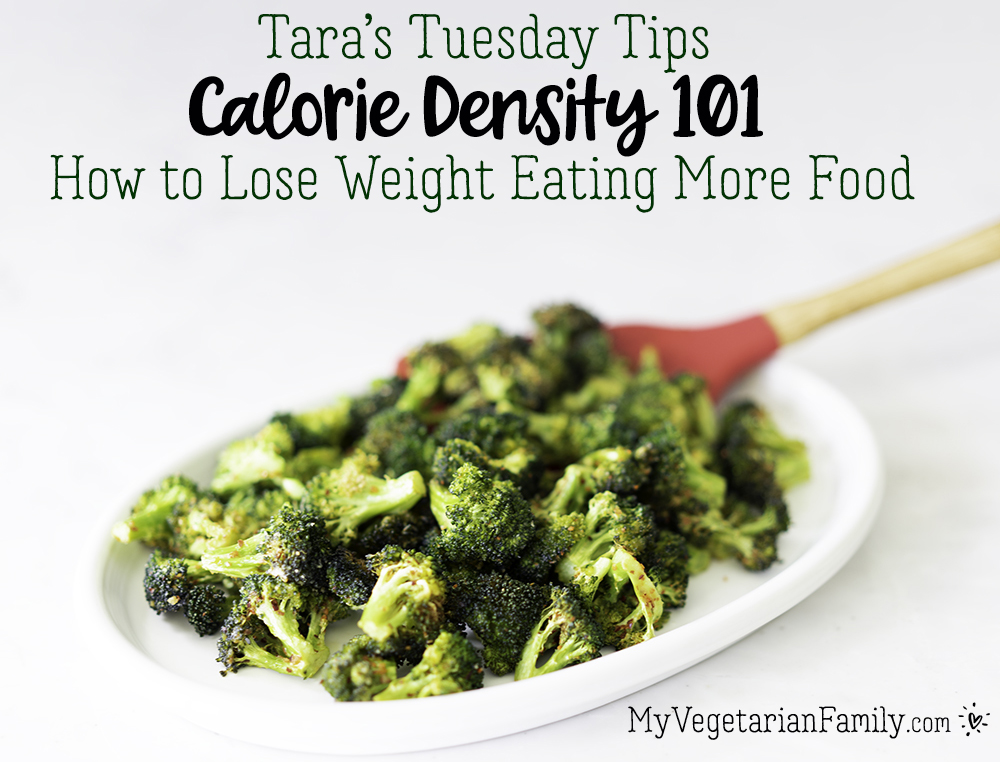
🧡Did you love reading Calorie Density 101? Leave a comment below! We love comments 🧡
📸Be sure to follow me on Instagram @myvegetarianfamily + follow my daily food journey
💌Be sure to subscribe here to my weekly emails for tips and recipes so that you never miss a veggie thing!
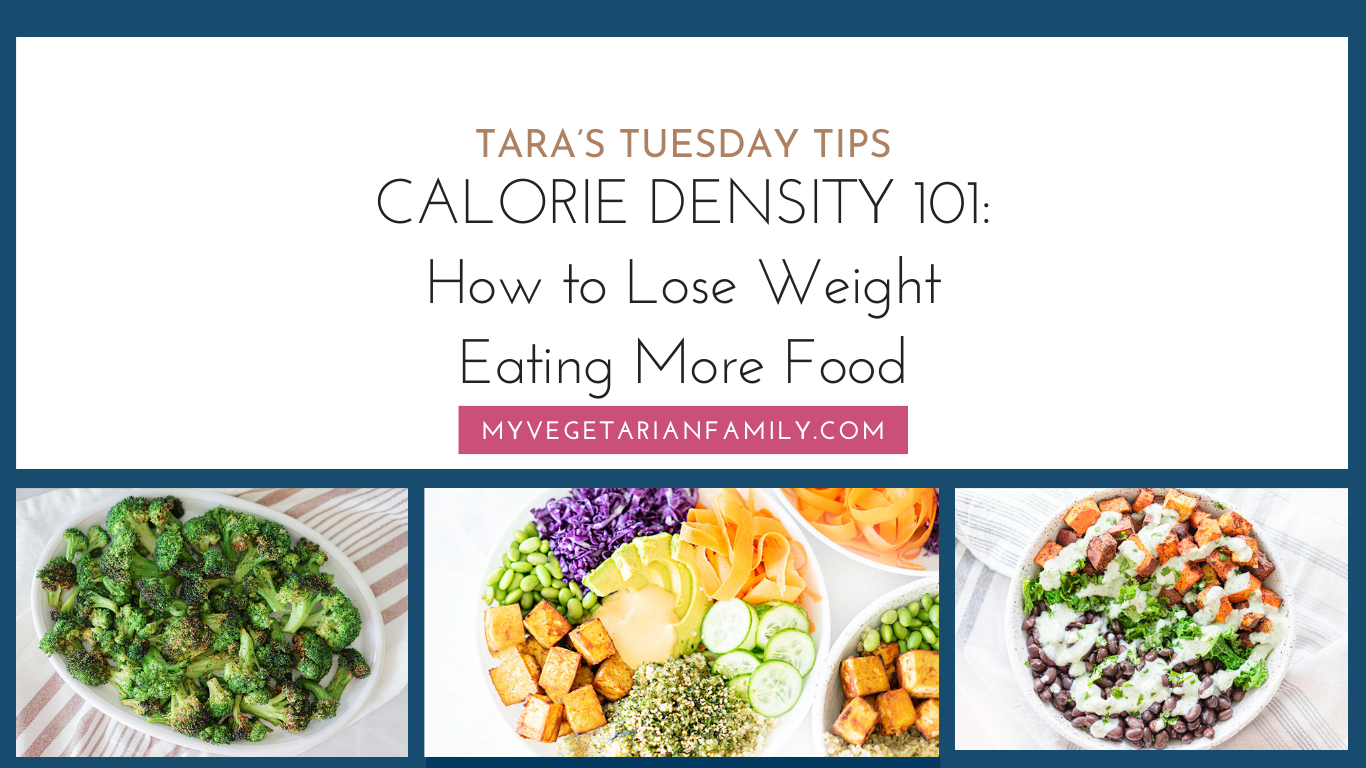



Wow! This Is totally awesome information. Thanks soooo much.
Hi!!! YES! Super easy to make a few changes + you will see … eat primarily low-calorie-density foods and you will definitely feel full and cut out a lot of higher calorie foods!
Thanks for the great information ! I’m going to be eating a lot more fruits and veggies ! Great article!
I am so happy to enjoyed this article! More fruits + veggies is a great idea!